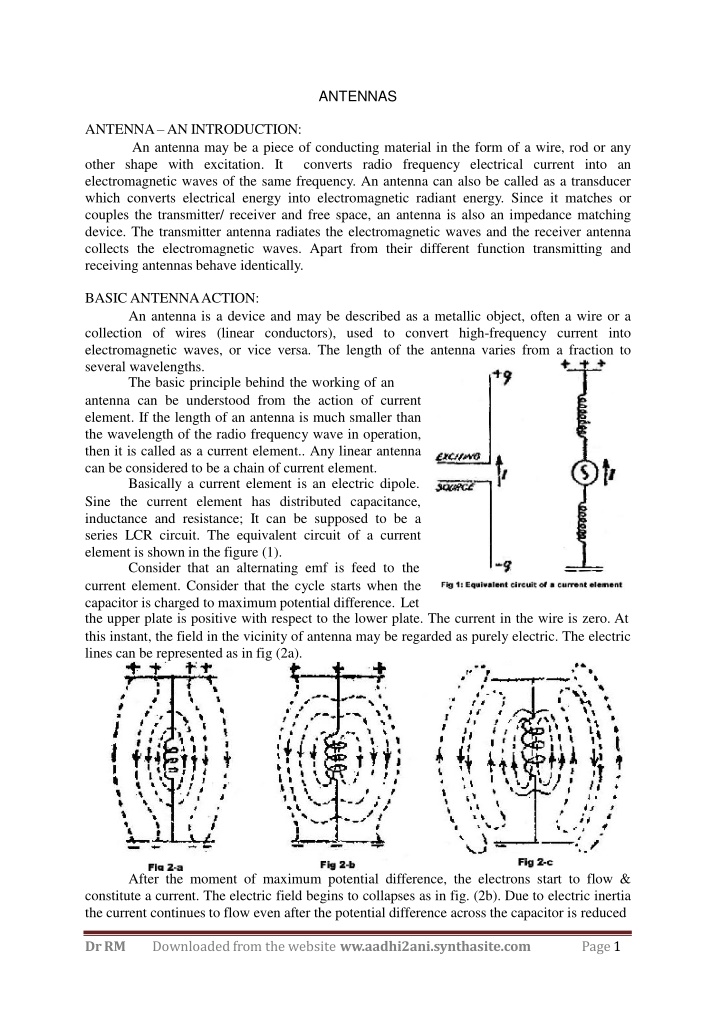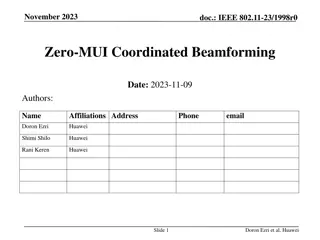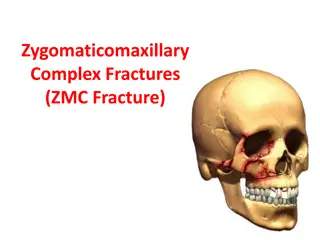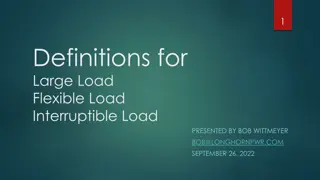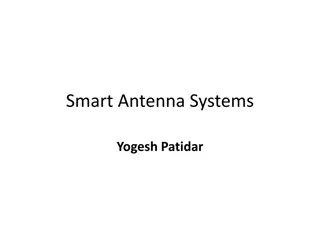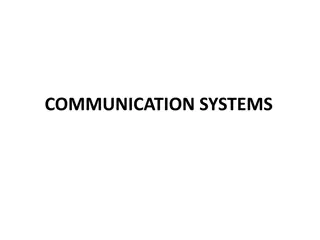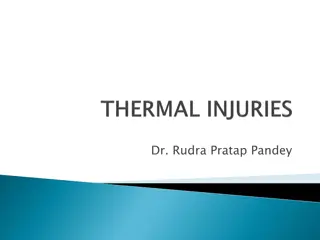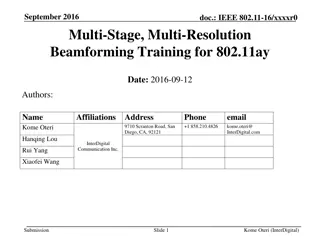Antennas: Basics and Classifications
An antenna is a crucial device that converts radio frequency electrical current into electromagnetic waves. This article discusses the fundamental principles behind antennas, their action as transducers, and different classifications based on directional patterns. Whether you're interested in isotropic radiators, directional antennas, or omni-directional antennas, this informative piece provides insights into the world of antennas.
Uploaded on Oct 06, 2024 | 1 Views
Download Presentation

Please find below an Image/Link to download the presentation.
The content on the website is provided AS IS for your information and personal use only. It may not be sold, licensed, or shared on other websites without obtaining consent from the author.If you encounter any issues during the download, it is possible that the publisher has removed the file from their server.
You are allowed to download the files provided on this website for personal or commercial use, subject to the condition that they are used lawfully. All files are the property of their respective owners.
The content on the website is provided AS IS for your information and personal use only. It may not be sold, licensed, or shared on other websites without obtaining consent from the author.
E N D
Presentation Transcript
ANTENNAS ANTENNA AN INTRODUCTION: An antenna may be a piece of conducting material in the form of a wire, rod or any other shape with excitation. It converts radio frequency electrical current into an electromagnetic waves of the same frequency. An antenna can also be called as a transducer which converts electrical energy into electromagnetic radiant energy. Since it matches or couples the transmitter/ receiver and free space, an antenna is also an impedance matching device. The transmitter antenna radiates the electromagnetic waves and the receiver antenna collects the electromagnetic waves. Apart from their different function transmitting and receiving antennas behave identically. BASIC ANTENNA ACTION: An antenna is a device and may be described as a metallic object, often a wire or a collection of wires (linear conductors), used to convert high-frequency current into electromagnetic waves, or vice versa. The length of the antenna varies from a fraction to several wavelengths. The basic principle behind the working of an antenna can be understood from the action of current element. If the length of an antenna is much smaller than the wavelength of the radio frequency wave in operation, then it is called as a current element.. Any linear antenna can be considered to be a chain of current element. Basically a current element is an electric dipole. Sine the current element has distributed capacitance, inductance and resistance; It can be supposed to be a series LCR circuit. The equivalent circuit of a current element is shown in the figure (1). Consider that an alternating emf is feed to the current element. Consider that the cycle starts when the capacitor is charged to maximum potential difference. Let the upper plate is positive with respect to the lower plate. The current in the wire is zero. At this instant, the field in the vicinity of antenna may be regarded as purely electric. The electric lines can be represented as in fig (2a). After the moment of maximum potential difference, the electrons start to flow & constitute a current. The electric field begins to collapses as in fig. (2b). Due to electric inertia the current continues to flow even after the potential difference across the capacitor is reduced DrRM Downloaded from the website ww.aadhi2ani.synthasite.com Page1
to zero. As a result the capacitor starts to charge in opposite direction. This will setup a new electric field between the plates. If the initial electric field lags on the changes in the potential which causes it, then this new electric field will start to build up before the first one has disappeared. As a result, the first disturbance is repulsed outward in the form of closed loops by the new electric field as shown in fig (2c). Any changing or moving electric field must have magnetic field associated with it. Thus, on addition to the electric field, we must regard to circuit as being surrounded by rings of changing magnetic lines in a direction normal to the direction of electric field.. Therefore, both the electric and magnetic fields are moving in closed loops outward from the antenna. Thus there is no time quadrature between the radioactive fields, but essential space quadrature is always maintained. ANTENNACLASSIFICATIONS I: Antennas are classified in many different ways. Based on their directional pattern they can be classified as Isotropic radiators, directional antennas and omni directional antennas. ISOTROPIC RADIATORS: An isotropic radiator is defined as a hypothetical element which radiates equally in all directions. It is an ideal antenna but it is not realizable practically. It is useful as s reference antenna for determining directive properties of practical antennas. DIRECTIONAL ANTENNAS: electromagnetic wavers more effectively in some direction than in others. Examples: Dipoles, horns, paraboloids, etc. These are the antennas which radiate or receive OMNI-DIRECTIONAL ANTENNAS: It is defined as an antenna which has a non directional pattern in azimuth and has a directional pattern in elevation. An omni directional pattern is a special type of directional pattern. E.g.: Acircular loop antenna, vertical hertz antenna, quarter wave monopole. DrRM Downloaded from the website ww.aadhi2ani.synthasite.com Page2
ANTENNA CLASSIFICATIONS II: Antennas are also classified as resonant and non-resonant antennas depend upon the length of the antenna and the wavelength of radiation. RESONANTANTENNAS: The length of a resonant antenna is an exact multiple of /2. These antennas are open at both ends. They are not terminated in any resistance. The voltage and current on it are not in phase. A standing wave exists in these antennas. The radiation patterns of these antennas are multi-directional. Such antennas are used at a fixed frequency. They are also called as periodic antennas. NON-RESONANT ANTENNAS: The length of a non-resonant antenna is other than in multiples of /2. At one end of the antenna, it is excited and the other end is terminated. It is terminated with by characteristic impedance. As it operates over a range of frequencies, it has a wide bandwidth. There are no standing waves on this antenna. It produces directional radiation pattern. The resonant antennas can also be called as directional antennas. ANTENNA CLASSIFICATIONS III: Based on the frequency range over which the antennas can be used they can be classified as LF, HF, VHF, UHF and microwave frequency antennas. ANTENNAPARAMETERS: ANTENNA IMPEDANCE: It is defined as the ratio of input voltage to input current Z =Vi ohms i.e. a I i Za is a complex quantity and it is written as Za = Ra +jXa DrRM Downloaded from the website ww.aadhi2ani.synthasite.com Page3
Here, the reactive part Xa results from fields surrounding the antenna. The resistive part, Ra is given by Ra = Rl +Rr Rl represents losses in the antenna and Rr is called as radiationresistance. RADIATION RESISTANCE: Radiation resistance is defined as the ratio of the power radiated by the antenna to the square of the current fed to the antenna. R =Powerradiated i.e. r rms I2 It is not a DC resistance, but rather an AC one, like the equivalent resistance of a parallel tuned circuit. It is part of the antenna input impedance and its use greatly simplifies antenna efficiency calculations. It can also be defined as a fictitious or hypothetical resistance that would dissipate an amount of power equal to the radiated power. DIRECTIVE GAIN: It is defined as the ratio of the power radiated by a given antenna (Pa) to that of the power radiated by an isotropic antenna (Por) to develop the same filed strength at a point (Here power is measured in both the cases at the same distance from the antenna). i.e. gd= Pa/Por If Pris total power radiated by the given antenna then Por= Pr/4 It is also defined as the ratio of the intensity of radiation in a specified direction to the average radiation intensity. RI i.e. g = RI = d P /4 RI av r =4 RI or g d P r where Pr is the radiated power by the givenantenna. DIRECTIVITY: Directivity is the maximum directive gain and it is usually denoted as D. It is defined as the ratio of the maximum radiation intensity to the average radiation intensity. i.e. when expressed indB D = 10log10(gd)max Since any directional antenna or array usually radiate maximum power only in one particular direction we need not specify the direction of directivity. D = (gd)max POWER GAIN: : It is the ratio of the power density that must be radiated by an antenna in a direction to that of the power density radiated by an isotropic antenna in the same direction when both the antennas are fed with same power. Pa = i.e., g P P ot If Pt is total power fed to the given antenna then Pot = Pr / 4 . Here Pt is the total input power and Pt = Pr + Pl . Pl is the power loss in theantenna. It can be noted that the power gain, gp, taken into account the input power whereas the directive gain considers the radiated power. In other words directive gain and power gain are identical except that power gain takes into account the antenna losses. RADIATION EFFICIENCY or ANTENNA EFFICIENCY: It is defined as the ratio of the radiated power of an antenna to the input power to the antenna. DrRM Downloaded from the website ww.aadhi2ani.synthasite.com Page4
gp gd Pr =Pr= = i.e. Pr + Pl Pt Power fed to the antenna may partially be wasted due to antenna and ground resistance, eddy currents induced in nearby metallic structures, discharge effects, losses in imperfect dielectrics near the antenna, etc. All these losses are represented by a quantity called lumped resistance Rl. If the radiation resistance is Rr, the sum of Rland Rris the total resistance of the antenna. The antenna efficiency is then defined as the ratio of the radiation resistance to the total resistance of an antenna i.e. = Rr/ [Rr+Rl] For an isotopic radiator there are no losses, so the radiation efficiency is unity or 100 %. Low and medium frequency antennas are less efficient because making them to resonant length leads to high structures. BAND WIDTH: The term bandwidth refers to the frequency range over which antenna operation is satisfactory. It is defined as the range of frequencies over which the antenna maintains its characteristics and parameters, like gain, directivity, impedance, etc., without considerable change. BEAM WIDTH: The beam width of an antenna is the angular separation between the two half-power points on the power density radiation pattern. The half-power points are the points at which the received power falls to one-half of the maximum power, on either side of the maximum power point. It is also, the angular separation between two points where the field strength has fallen to 1/ 2 of its maximum value. Beam width is quoted in degrees. Fig explains diagrammatically the bandwidth of an antenna. RADIATION PATTERN: The radiation pattern of an antenna is a graphical representation of radiation as a function of direction. This is also called as radiation characteristics or directional characteristics. They indicate the distribution of radiation power in free space in different angular regions. These are of two types: (i) field strength pattern and (ii) power pattern. (i) Field strength pattern: It is the variation of the absolute value of the field strength as a function of . i.e. E vs is called as field strength pattern. Power pattern: It is the variation of the radiated power as a function of i.e. P vs is called as Power pattern. The power pattern is proportional to the square of the field strength pattern. The patterns are plotted either in polar coordinates or in a linear coordinates. The patterns represented far-filed variation. A three dimensional pattern plotted as a function of and gives the complete information. Sometimes, cross sections of patterns in horizontal planes and vertical planes presented. (ii) DrRM Downloaded from the website ww.aadhi2ani.synthasite.com Page5
Elementary or SHORTDOUBLET: SHORT DOUBLET: A short linear conductor is often called a short doublet or short dipole. It is the simplest wire antenna. It is infinitely thin and has length, dl, which is very short compared to the wavelength. Any linear antenna can be considered to be made up of large number of short doublets in series. This in order to understand the action of any antenna, the study of radiation properties of a doublet is highly useful. RADIATIVE FIELD STRENGTH DUE TO A SHORT DOUBLET: Let the length of the doublet be dl, which is very small compared with the wavelength radiated by it. The expression for the magnetic field at a distant point (r) is dH =Io dlsin cos (t r /c) 4 rc dH =Iodlsin cos (t r/c) or Ampere-turn/meter (1) 2 r the corresponding electric field will be 0 / 0 dH dE = dE = 120 dH or Using equation (6) in (8), we have (2) Io dlsin 2 r cos (t r/c) dE = 120 dE =60 Iodlsin cos (t r/c) Therefore, volt / meter (3) r Equations (1) and (3) give the electric and magnetic field produced at a distance r from the current element. The radiated power of an elementary doublet is given by the formula dl The radiation resistance of the elementary doublet can be shown to be equal to dl 2 P = 80 2 I2 watts T eff 2 R = 80 2 ohms r HALF-WAVE DIPOLE ANTENNA: One of the simplest antennas, which are the basis for more complex directional antenna systems, is a half-wave antenna. A schematic diagram of the half-wave antenna is shown in the figure-1. Half-wave antennas will have length half of the wavelength ( ) transmitted or received by the antenna i.e /2. DrRM Downloaded from the website ww.aadhi2ani.synthasite.com Page6
The RF energy from the transmission line is fed at its centre. Because of the central feed the two ends of the aerial are at opposite potentials. The current will, be distributed in such a way that current value is zero at the ends and maximum at the centre. The potential and current distribution in a half wave dipole is shown in the figure-2. Ideally, a half-wave ( /2) dipole should be fed with a balanced line matching the theoretical 73 ohm impedance of the antenna. A folded dipole uses a 300 ohm balanced feeder line. Sometimes a coaxial cable is used as the feeder line. But this is not a balanced feed. When a dipole is used both to transmit and to receive, the characteristics of the feedline become much more important. Specifically, the antenna must be balanced with the feedline. Failure to do this causes the feedline, in addition to the antenna itself, to radiate. RF can be induced into other electronic equipment near the radiating feedline, causing RF interference. Furthermore, the antenna is not as efficient as it could be because it is radiating closer to the ground and its radiation (and reception) pattern may be distorted asymmetrically. The formula for the magnitude of the magnetic filed at a distance r from the half wave dipole can be shown to equal to cos cos 2 2 r The formula for the magnitude of the electric filed at a distance r from the half wave dipole can be shown to equal to cos cos 2 60I E = r I H = 0 sin 0 sin The power radiated by the half-wave antenna is P = 73I2 rms Thj radation resistance is about 73 ohms. i.e., Rr = 73 ohms =36.5I2 0 DrRM Downloaded from the website ww.aadhi2ani.synthasite.com Page7
The maximum directive gain or directivity of this antenna is: D = 1.64 D = 2.15 dB or Radiation pattern and gain The radiation pattern of the half-wavve antenna in three dimension is a slightly flattened torus as shown in the figure-3. Figre-4 shows the radiation pattern of the dipole in two dimension. It is basically a power pattern. We can see that the power pattern for elementry doublet and halfwave dipole are very similar. Fig-4a shows the radation pattern of half wave dipole in horizontal cross section and Fig -4b shows the pattern in vertical cross section. We have drawn, in dotted lines, the emission pattern of a short dipole, for comparison purpose. Common applications of dipole antennas Set-topTV antenna: The most common dipole antenna is the "rabbit ears" type used with televisions. While theoretically the dipole elements should be along the same line, "rabbit ears" are adjustable in length and angle. Larger dipoles are sometimes hung in a V shape with the center near the radio equipment on the ground or the ends on the ground with the center supported. Folded dipole Another common place one can see dipoles is as antennas for the FM band - these are folded dipoles. The tips of the antenna are folded back until they almost meet at the feedpoint, such that the antenna comprises one entire wavelength. The main advantage of this arrangement is an improved bandwidth over a standard half-wave dipole. The folded dipole works in the same way as a normal dipole, but the radiation resistance is about 300 ohms rather than the 75 ohms which is expected for a normal dipole. The increase in radiation resistance allows the antenna to be driven from a 300 ohm balanced line. YAGI-ANTENNA: The Yagi antenna or Yagi-uda antenna is a parasite array comprising a driven Half-wave dipole antenna which is usually a folded dipole, a single reflector, and one or more direction elements. The structure is illustrated in fig. (1a). A director is shorter than the driver and is located in the direction of desired transmission or recitation. The directive gain of antenna is DrRM Downloaded from the website ww.aadhi2ani.synthasite.com Page8
considerably increased by the addition of more directors. Up to 13 directors can be added. The director increases radiation in its own direction. Areflector is longer than the driver and is placed in a plane away from the direction of desired transmission or reception. The reflector reduces signal strength its own direction & increases it in the opposite direction. Only one reflector need be used, since the addition of a second or third reflector adds practically nothing to the directivity of the structure Afolded dipole is often used as the driven element folded dipole has the same radiation pattern as the ordinary dipole. But, it has two advantages (1) higher input impedance & (2) greater bandwidth. The director and reflectors are grounded to the support boom at their centers, while the driver, split at the center feed point, must remain insulated from ground. The reflector & directors are called as parasitic elements, because they receive energy through the induction field of the driven element The radiation pattern of the Yagi antenna is shown in fig.(2). The pattern consists of one main lobe lying in the forward direction along the axis of the array, with several minor lobes in other directions. It is used as an HF transmitting antenna. It is also employed as VHF television receiving antenna. Its high directional gain makes it ideal for point-to- point fixed-frequency communication networks. The optical equivalent of the Yagi antenna is shown in the fig-3. Salient features of Yagi-Uda antenna 1.The length of the folded dipole is about /2 and it is at resonance. Length of the director is less than /2 and length of the reflector is greater than / 2. 2. Its radiation pattern is almost unidirectional and gives a gain of about 7 dB 3. It is used as a transmitting antenna at HF and used for TV reception at VHF. 4.The effect of parasitic elements depends on their distance and tuning. In other words, the effect depends on the magnitude and phase of the current induced in them. 5 Reflector resonates at a lower frequency and director resonates at a higher frequency compared to that of a driven element. 6.Folded dipole is used to obtain high impedance for proper matching between transmitter and free space. 7. It is relatively broadband because of the use of folded dipole. 8. Although it is compact, its gain is not high. 9. Yagi-Uda antenna has exceptional sensitivity. PARABOLIC REFLECTOR: An introduction The microwave region extends from 1 GHz to 100 GHz. The transmitting and receiving antennas in microwave frequencies are directive with high gain and narrow beam width in both vertical and horizontal planes. One of the most popular antennas in the microwave region is Parabolic reflector. Other antennas such spherical reflector, cylindrical reflector, corner reflector are also in use. DrRM Downloaded from the website ww.aadhi2ani.synthasite.com Page9
Construction and working It is a reflector antenna which has the shape of paraboloid and employs properties of parabola. It can also be defined as a reflector which is part of a paraboloid of revolution. A paraboloid is a three dimensional surface obtained by revolving parabola about its axis. The paraboloid is called the parabolic reflector or antenna. The geometry of a parabolic reflector in transmitting mode is shown in Fig. Operation of parabolic reflector If a feed antenna is placed at the focus, all the waves are incident on the reflector and they are reflected back, forming a plane wave front. By the time the reflected waves reach the directrix, all of them will be in phase, irrespective of the point on the parabola from which they are reflected. Hence the radiation is very high and is concentrated along the axis of the parabola. At the same time, waves will be cancelled in other directions as a result of path and phase differences. The main purpose of the parabolic reflector is to convert a spherical wave into a plane wave. Salient features of parabolic reflectors: 1.The reflector is called the secondary antenna and feed antenna is called the primary antenna. 2. The radiation pattern of primary antenna placed at the locus of the parabolic reflector is called the primary pattern. The radiation pattern of the entire system consisting of primary and secondary antenna is called the antenna pattern. 3. A mesh surface is often used to minimize wind effect on the antenna and extra strain on the supports. This also reduces distortion caused by uneven wind force distribution over the surface. 4. The directional beam has s sharp main lobe surrounded by several side lobes. 5.Effective Radiated Power (ERP) = product of input power to the antenna and power gain. It is very high even for small input power. 6. Very large gains and narrow beam width are obtainable with paraboloid reflectors. 7. Paraboloids are not used at low frequencies because of large size. 8. In order to be fully effective and useful, its mouth diameter must be at least 10 . 9.Performance of paraboloid reflectors depends on the radiation characteristics of primary antenna and its size. 10. Parabolic reflectors have several applications in communications and radars. DrRM Downloaded from the website ww.aadhi2ani.synthasite.com Page10
Disadvantages of paraboloid reflectors 1.The radiation beam is a pencil beam and it is surrounded by side lobes. These side lobes create electromagnetic induction and the effect of electromagnetic interference is more prominent in low noise receivers due to the imperfections in the reflector. 2. Deviations from the true shape of a paraboloid should not exceed one sixteenth of . Such tolerances may be difficult to achieve in large dishes whose surface is a network of wires instead of a smooth continuous skin. SATELLITE COMMUNICATION Introduction: High frequency radio and submarine cable system have been widely used for long distance overseas telecommunication. They have series drawbacks of high noise levels and limited bandwidth. Since ionospheric reflection is not possible for very high frequencies, communications with such high frequencies require line of sight links. The advent of satellites revolutionized the long distance communication. Communication through satellites has very minimum noise level and wide bandwidth. The acts as microwave repeaters on the sky and can be used at any desired altitudes to cover thousands of kilometers. Acommunications satellite is a spacecraft placed in orbit around the earthwhich carries on board microwave receiving and transmitting equipment capable of relaying signals from one point on earth to other points. Microwave frequencies must be used to penetrate the ionosphere, since all practical satellite orbits are at heights well above the ionosphere. Also, microwave frequencies are required to handle the wideband signals encountered in present- day communication networks, and to make practical the use of high gain antennas required aboard the spacecraft. Communications satellites may be passive or active.Apassive satellite act as a passive reflector of electromagnetic signals beamed from earth stations. An active satellite is an active relay to receive the signals process them for frequency translation and power boosting and beam down for reception to a network of earth stations. Satellites presently in use are active satellites. This means that the satellite has on- board, highly directional transmitting and receiving antennas, and complex inter connecting circuits.Accurate positioning and control mechanisms are required for the satellite. NOTE:The first commerciallyoperated satellite , namedEarly Bird, launched in August, 1965. Since that time numerous satelliteshavebeenlaunchedfortelecommunicationspurposes.SomeoftheImportantcommunicationsatellitesare Intelsat series, Satellitesystemsmaybedomestic,regionalorglobalin character.Theservicerangeofa domestic satellite system is confinedto the countryowningthe system,for example,the CanadianTelesatsystem. Regionalinvolvetwo or morecountries,suchastheFrench-westGermanSymphonicsystem.Globalsystemsareinter-continentalin characterand abestexampleisIntelsatsystem. COMMUNICATIONS SATELLITIES ORBITS: A satellite orbiting the earth stays in position because the centripetal force on the satellite balances the gravitational attractive force of the earth. In addition, atmospheric drag must be negligible, and this requires the satellite to be at a height greater than about 600 Kim. The choice of orbit is of fundamental importance, as it determines the transmission path loss and delay time, the earth coverage area, and the time period the satellite is visible from any given area. For satellite communications purposes, orbits are conveniently classified as (i) DrRM Downloaded from the website ww.aadhi2ani.synthasite.com Page11
inclined elliptical, (ii) polar circular, and (iii) Geo-stationary. Each of these is illustrated in fig-(1). The inclined elliptical orbit is not widely used. Its main advantage is that is provides coverages of the Polar Regions. For example, it is used for the Russian Molniya/ orbita satellite broadcast system where coverage of the more remote regions of the country is required. The apogee, or highest point of the orbit, is arranged to occur over the region requiring most coverage. This puts the satellite at its greatest height and therefore gives the greatest earth coverage in this region. Also, the transit time is longest at the apogee, making the satellite visible for a relatively long period of time over these regions. The inclined elliptical orbit does not permit continuous contact with the satellite from a fixed spot on earth. The circular polar orbit is not used for communications satellites generally, but it is used for special purposes such as navigational satellites. Most of the communications satellites are used in circular equatorial orbit. It is also called equatorial geo-synchronous orbit or geo-stationary orbit or Clarke orbit. The periodic time is the time taken for one complete orbit, and a synchronous orbit is one for which the periodic time is an integer multiple or sub-multiple of the earth s rotational period. The geo- stationary orbit is the synchronous orbit which is most widely used. The rotational period of the earth about its own axis is 23 hours and 56 minutes, and a satellite in geo-stationary orbit, traveling in the same directions as the earth s rotation, completes one revolution about the earth s axis in this time. The satellite therefore appears stationary to an observer on earth hence the name geo-stationary. The height of the geo-stationary orbit from the surface of the earth is 35,855 km. The forward velocity of the satellite is about 11,062 km/hr. Keeping track of a geo-stationary satellite is relatively easy, and the satellite is continually visible from within is service area on earth. Another advantage of the geo-stationary orbit is that the Doppler shift of frequency is negligible. HEIGHT OF GEO-STATIONARYORBIT: The height required for geo-stationary orbit may be deduced from the dynamics of motion. For a circular orbit at height h above ground, Circumferential path is = 2 (R + h), where R is the average radius of the earth Motion in a circle implies that the circumferential speed V is constant, and therefore T =2 (R +h) & R = 6371km. the time for one orbit is V From the mechanics of the situation, the centripetal force on a satellite of mass M V2 fc =R +h M is DrRM Downloaded from the website ww.aadhi2ani.synthasite.com Page12
And the gravitational force is Mg', where g' is the gravitational acceleration at the satellite height. This in tern is related to the gravitational acceleration g at the earth s surface by R g =g R +h Balancing the centripetal force against the gravitational force gives R M V2 2 2 Mg = R +h R+h g V = R R+h Substituting this expression for V in equation (1) and solving for h we get 2 (R +h) R g /(R + h) 2 (R+ h)3/ 2 T = T = Rg1/ 2 T Rg1/ 2 2 T 2 R 2g 4 2 h = 4 2 = (R+ h) 3/2 = (R +h) 3 1 R2g 3 2 R Therefore, T 3 When the numerical values are substituted for a and g gives h = (5077 T 2/3 6371)Km. Here, T is time in hours. Substituting T = 24 hours gives h = 35,865 km as the height of the geostationary orbit. THE SATELLITE SYSTEM: Figure (1), shows the block diagram of a communication satellite system. basically five sections within the satellite, each totally dependent on the other four. 1. The electronics section, called the transponder 2. The antenna sub-system 3.The power package sub-system, The station-keeping section, made up of 4. The control and information section 5. The rocket thruster section There are The Transponder: The transponder is a high-frequency radio receiver, a frequency down-converter and a power amplifier used to transmit the down-link signal. It receives a modulated signal on one carrier frequency and retransmits the same information on a lower carrier frequency. It does not carry out any demodulation or signal clean up processing. There are single-transponder DrRM Downloaded from the website ww.aadhi2ani.synthasite.com Page13
satellites and multi-transponder satellites. Multi transponder systems are common now-a- days. TheAntenna Systems: The antennas in the satellites are high gain, antennas operating in GHz range. There may be more than one antenna in a satellite. The antennas aboard the satellite are also highly directional in nature. This makes the antenna, to send the beam to the desirable location on earth easily and efficiently. Most commonly used antennas are Dish-antennas, Horn antennas, etc. The Power Package Sub-System: The power for modern-day satellites is derived from the sun with the help of solar cells. Solar cells are arranged to form flat panels, called arrays. This flat solar panel arrays are oriented towards sun to obtain the power. Satellites in the geo-stationary orbit are eclipsed by the earth for about 1.5 hours during each orbit. Thus, to operate the satellite during eclipses, it must carry storage batteries, which are charged by the solar panels. The Station Keeping System: This system keeps the satellite in the correct orbit with the antennas pointed in the exact direction desired. Satellites aboard many sensors which send information regarding satellites altitude, velocity, roll, yaw, and pitch attitudes to ground station. Commands to maintain the satellites at correct orientation etc., are sent from ground station to satellites. Thus, there is a constant two-way communication between the devices aboard the satellite and the ground computer terminals. This represent the control and information or telemetry section of the vehicle. There are several small rocket thrusters aboard the satellite that modify the forward and retro velocity of the spacecraft. There are also six other small thrusters that control yaw, DrRM Downloaded from the website ww.aadhi2ani.synthasite.com Page14
pitch and roll. These thrusters along with the control and information section constitute the two remaining section of the satellite. EARTH STATION: The ground segment of a satellite communication system consists of (i) ground terminal that controls and monitors the satellite and (ii) the various earth stations that operate with each other via the satellite. The master earth station is equipped with telemetry and telecommunication facility. The station, monitors the health of the satellite using the telemetry facility, and keeps a track of the satellite and controls the satellite orbit. Another major function of this station is to monitor the signal reaching the spacecraft from the various earth stations and to ensure that no earth station transmits more power to the satellite than is required for proper system operation. Generally there will be many smaller earth stations which are used mainly to send and receive signals to the satellite. Figure shows a typical block diagram of an earth station used for telecommunication. The major sub systems are: (1) Antenna and feed (2) Tracking and servo control (3) Low noise amplifier (4) High power amplifier (5) up and down converters (6) Modulators and demodulators (7) Base band and multiplex equipment and (7) Power supply system. Antenna and Fed: This is one of the costliest sub systems in an earth station. Most of the domestic satellite systems use antennas with diameters in the range of 10 to 15 meters, for the heavy route stations. Thin route stations have antennas as small as 3 meters in diameter. The following parameters are taken into account in designing an antenna system type of mount, sterrability, gain, beam width, side lobe levels pointing accuracy and wind speed. Three types of mounting systems are availability for earth station antennas. They are (i) Azimuth elevation mount (ii) X-Y mount and (iii equatorial mount. The earth station antennas invariably uses Cassegarain feed system. This feed minimizes the system noise temperature and system loses. Tracking and servo system: Continuously pointing the earth station antenna towards the satellite is very essential and it is called as tracking. Even a geostationary satellite makes certain excursions relative to earth, so antenna has to keep track of the satellite. For tracking the satellite there are several methods: (1) manual tracking (2) auto tracking (3) programme tracking and (4) step tracking, etc. Auto tracking involves generation of an error signal for each axis, and then feeding this error signal to the servo control system to null the error. Programme tracking depends upon the accuracy of orbit predications. In this system the antenna is controlled by computer. DrRM Downloaded from the website ww.aadhi2ani.synthasite.com Page15
The computer computes the antenna pointing angles and periodically moves the antenna without jerk. Most modern earth stations uses auto or programme tracking. Low noise amplifier: The signal received from communication satellites are very weak and hence extremely low noise temperature receivers are employed in earth stations. The noise temperature of a receiver is defined as the equivalent temperature at which the receiver input has to be kept to produce the same noise power at the output. FET amplifiers are finding extensive use in thin route communication terminals. High power amplifier system: This is one of the critical and expensive item in an earth station transmit chain. The transmitter power required varies between few watts in the case of telephony to 3 kW in the case of television signals transmission. The ground station transmit power requirements is mainly dependent on the ground station antenna gain and the satellite figure of merit. Typical high power amplifiers in an earth station accept power input of the order of a few milli watts and amplify them to a power level of a few kilowatts. The basic device used for amplification is either a klystron or a traveling wave tube. UpAnd Down Converters: The up converters are used for translating the 70 MHz modulated signal to the 6 GHz transmitting band. Up conversion is normally done in two stages. First the70 MHz is up converted to an IF in the region between 500 to 3000 MHz, and then this is further up converted to 6 GHz band. Down converters are also be double conversion type. Modulators and demodulators The base band signal after suitable multiplexing modulates the 70 MHz carrier. The type of modulation depends on the signal format and access scheme. Television signal is normally frequency modulated, using a large deviation. Telephony signals are either frequency division multiplexed and then frequency modulated or time division multiplexed and then phase shift keyed. Similarly, demodulation process also depends on the access scheme and signal format. Power Supply System To achieve proper reliability in a commercial earth station, a no break power supply system has to be used. The no break power supply consists of rectifier, inverter, battery packs, diesel generator and associated switches. The total earth station load is divided into essential and non essential load and the essential load is connected to the no break power supply. SATELLITE COMMUNICATION FREQUENCIES: A communication satellite is essentially a microwave link repeater. The signals beamed to the satellite are called as uplink signals and the signals beamed down by the staelite are called as down link signals. Satellites receive energy beamed up at it by an earth station and returns to earth, after amplification, at a frequency of about 2 MHz away. The shifting of down link frequency away from the uplink frequency prevents interference between the uplink and downlink. Many communication satellites have been designed to operate in the so-called C band, which employs uplink/downlink frequencies of 6/4 gigahertz, or in the Ku band, in which uplink/downlink frequencies are in the range of 14/11 gigahertz. These frequency bands have DrRM Downloaded from the website ww.aadhi2ani.synthasite.com Page16
been selected to exploit spectral "windows," or regions within the microwave band in which there is low atmospheric attenuation and low external noise. Different microwave frequencies are used for the uplink and downlink in order to minimize leakage of power from on-board transmitters to on-board receivers. Because of the huge growth in satellite telecommunication since the 1970s, there are very few remaining slots for GEO satellites operating at frequencies below 17 gigahertz. This has led to the development of satellites operating in the Ka band (30/20 gigahertz), despite the higher atmospheric attenuation of signals at these frequencies. The World Administrative Radio Conference (WARC) coordinates the world wide allocation of radio frequencies. As per WARC 1979 allocation, commercial communication satellites working in C-band use 500 MHz bandwidth near 6 GHz for uplink transmission and use 500 MHZ bandwidth nears 4 GHz for downlink transmission. In actual practice, for uplink 5.725 7.075 GHz is used while for downlink 3.4 4.8 GHz is used. Foot Print: A communication satellite can able to transmit signals to a specific area on earth. The area over which the service of a satellite is available is called as foot print. The shape of the footprint is controlled by the design shape of the parabolic reflector and may differ for each satellite in orbit. The single beam single bigger foot print, is the more common in telecommunication networks. The footprint may be large or it could be made smaller to direct the transmission to a selected area. At the Geosynchronous orbit, one satellitecould command a footprint area of 42.2 % of the earth s surface. The beam width from the satellite for such coverage would be only 17.174 , as shown in the figure. A minimum of three satellites places 120 apart in the geosynchronous orbit would cover all of the earth s surface but the polar caps. satellite, generating altitude of the DrRM Downloaded from the website ww.aadhi2ani.synthasite.com Page17
